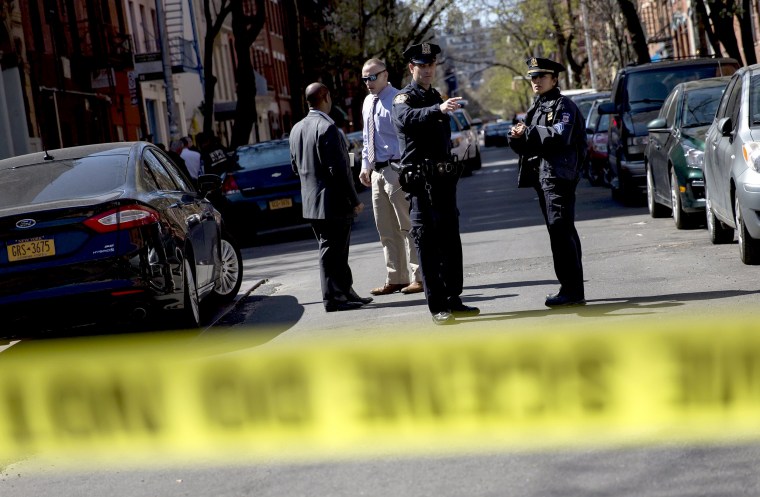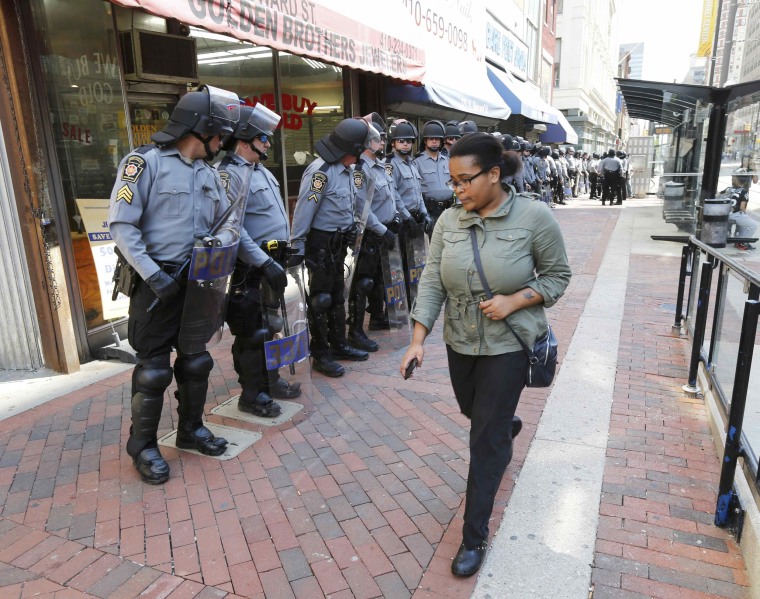Early one morning last month, a car pulled alongside a 43-year-old man on a motorcycle in St. Louis. A gunman inside opened fire, police said, hitting the rider several times before speeding off.
In a city suffering from an explosion in gunfire, the drive-by killing received only passing mentions in the press, noteworthy less for the circumstances than what it represented: 10 weeks before the end of the year, the city had surpassed its murder count for all of 2014.
Officials had been anticipating that grim milestone, debating whether the carnage was related to unrest that followed the August 2014 killing of a black man by a police officer in the suburb of Ferguson. St. Louis Police Chief Sam Dotson had called it "the Ferguson effect," a term that became a popular explanation for other crime spikes around the country. FBI Director James Comey later joined the chorus, saying that heightened scrutiny on police — the possibility of having their work caught on video and scrutinized publicly — had led to officers becoming less inclined to challenge people on the street.

But as 2015 draws to a close, researchers have begun to cast doubt on that theory.
There is little proof that the country is experiencing a crime wave, they say.
While many cities are suffering a rise in bloodshed and lawlessness, there are few discernible threads to tie them together.
Murders are up significantly in St. Louis and Baltimore, where there has been public unrest over the police tactics of use of force and stop-and-frisk. But other cities, such as Milwaukee, Chicago and Dallas, are facing spikes in killings without the protests.
"I don't think there's a trend," said Franklin Zimring, who studies crime at the University of California at Berkeley.
Figuring out why crime goes up and down is a complex and difficult undertaking. Police have earned much of the credit for an historic drop in crime that began in the early 1990s and continued through the turn of the century. But other possible factors — the economy, the aging population, even the amount of lead in people's bodies — don't involve law enforcement at all.

As talk spread this year of a nationwide uptick in violence, The Brennan Center for Justice, which advocates for reforms of the criminal justice system, got curious. Its researchers compiled data from the country's biggest cities and made projections of what crime rates would look like at the end of the year.
Their study, released last week, concluded that while killings and overall lawlessness were rising in some cities — the researchers predicted increases in both categories in Los Angeles, Houston, Charlotte, Denver and Baltimore — crime was continuing to drop nationwide.
The organization predicted that nationwide crime rates would drop 1.5 percent from 2014 to 2015.
“Although headlines suggesting a coming crime wave make good copy, a look at the available data shows there is no evidence to support that trend,” the report said.
The Major City Police Chiefs Association, which represents the country's largest cities, also did its own analysis. Compiling data from 53 cities, the association compared the first nine months of 2014 to the same period this year and found more than half reported increases in homicides, assaults or robberies, executive director Darrel Stephens said. Of the 32 cities that shared non-fatal shooting data, 24 reported upticks.
Stephens said he didn't disagree with The Brennan Center's conclusion that it was too early to show that crime was trending upward nationwide. But, he added, "it seems more than a coincidence that this many cities are experiencing these changes in the same year."
Spikes in some places, decreases in others: this is what a snapshot of America's largest cities usually looks like, researchers say. That lack of a pattern defies attempts to come up with a broad theory.
Even now, after decades of declining crime rates, no one's really sure why America got so much safer, Zimring said.
"When we can't explain these things confidently, we can't predict them. So everyone’s ready to worry — not because they know what drives crime rates, but because they don’t know what drives crime rates," Zimring said. "So all they can say to themselves is, 'We've been on a lucky streak.' That’s not very reassuring.”
The Brennan Center tried to delve a bit deeper into that question by studying five cities suffering from murder spikes this year: St. Louis, Baltimore, Detroit, Milwaukee, and New Orleans. The only shared circumstance that researchers said they could find was evidence of "profound economic decline": lower incomes, high poverty rates, falling populations and high unemployment.
Inimai Chettiar, director of the Brennan Center's justice program, acknowledged in an interview that economic factors still may not actually be a cause for the rise in murders in those cities. But they appeared to be a stronger explanation than the "Ferguson effect," she said.
In the end, Chettiar said, one thing is true about crime rates: "We can't make narratives out of individual examples."
But that disclaimer cuts both ways.
Alfred Blumstein, a criminal justice researcher at Carnegie Mellon University, said that while it was "much too early to defend anything like the Ferguson effect," it was also too early to dismiss it.
"It’s a complicated story, and it's going to vary by place and going to take a while before we really know it," he said. "But the opposition to it has been far more vigorous and has struck me as closer to a denial than counterargument."
Richard Rosenfeld, a criminologist at the University of Missouri at St. Louis and one of the nation's leading researchers on crime rates, said this confusion exposes the lack of timely data that could provide answers.
He blames the FBI.
The FBI compiles crime data from the country's 18,000 or so law enforcement agencies and publishes it annually. Rosenfeld has called on the agency to release that data — or some of it, at least — monthly.
"If there were a serious influenza outbreak, we’d be getting weekly updates from the CDC," Rosenfeld said, referring to the Centers for Disease Control and Prevention. "Certainly when crime spikes in places like St. Louis and Milwaukee and New Orleans, we need to find out what’s behind that."
Rosenfeld said he found it ironic that even Comey has acknowledged the lack of statistical evidence to back up the notion of a Ferguson effect.
"His own agency has the evidence he could use, and for whatever reason, he's not."
The FBI responded with a statement saying it agreed that it needed to release crime data more frequently.
Stephen Fisher, spokesman for the agency's Criminal Justice Information Services Division, said in an email that the FBI was in the process of updating its Uniform Crime Reporting Program to make its data available online "in a more real-time basis for the American public."
But Fischer noted that the effort would depend on state authorities to share their local data each month.
Whether they agree remains an open question.
